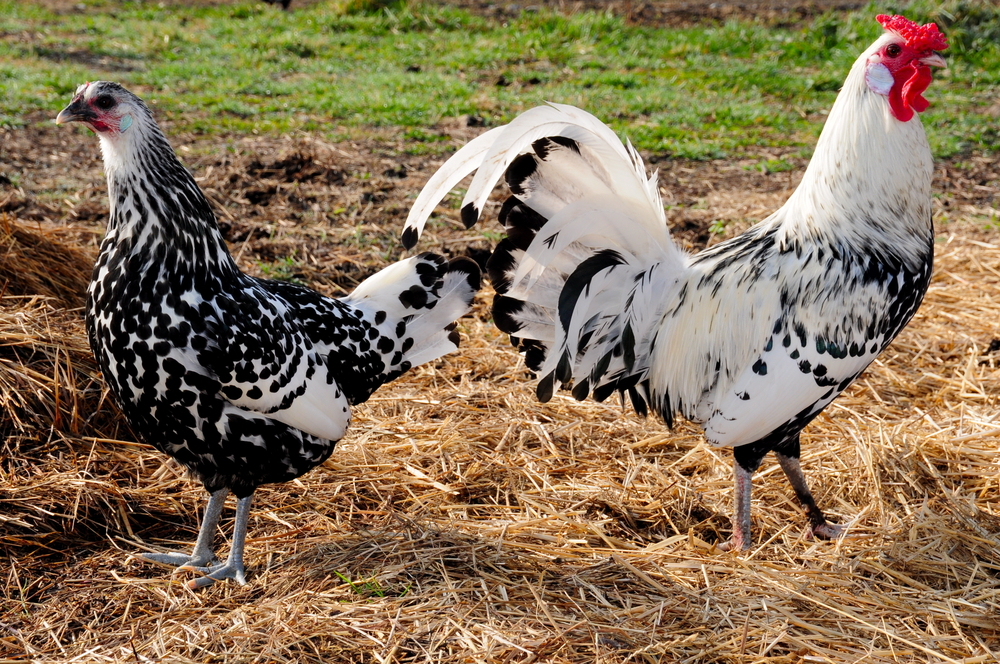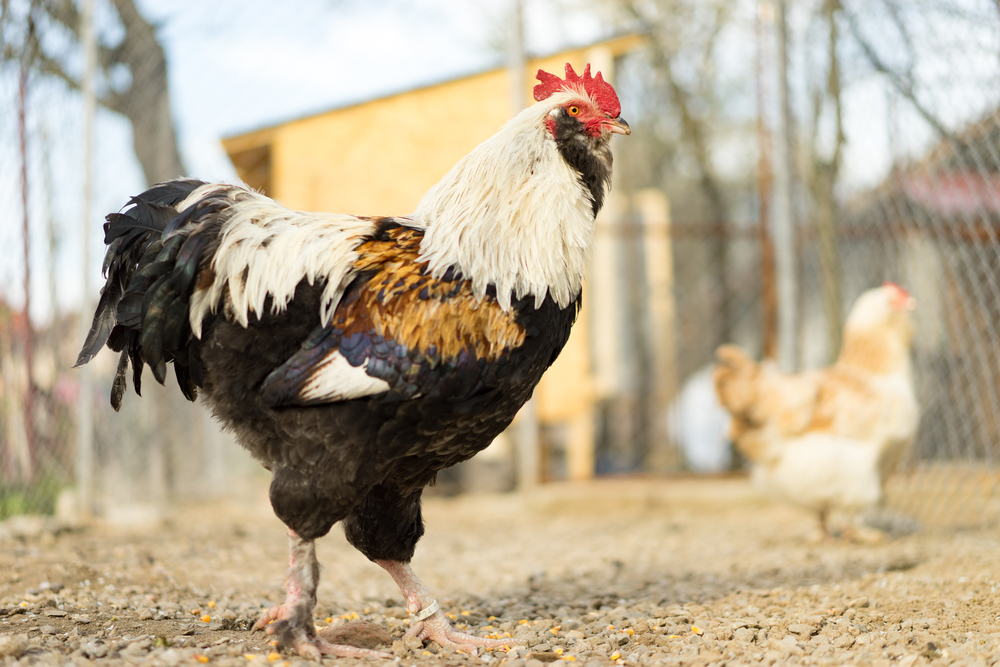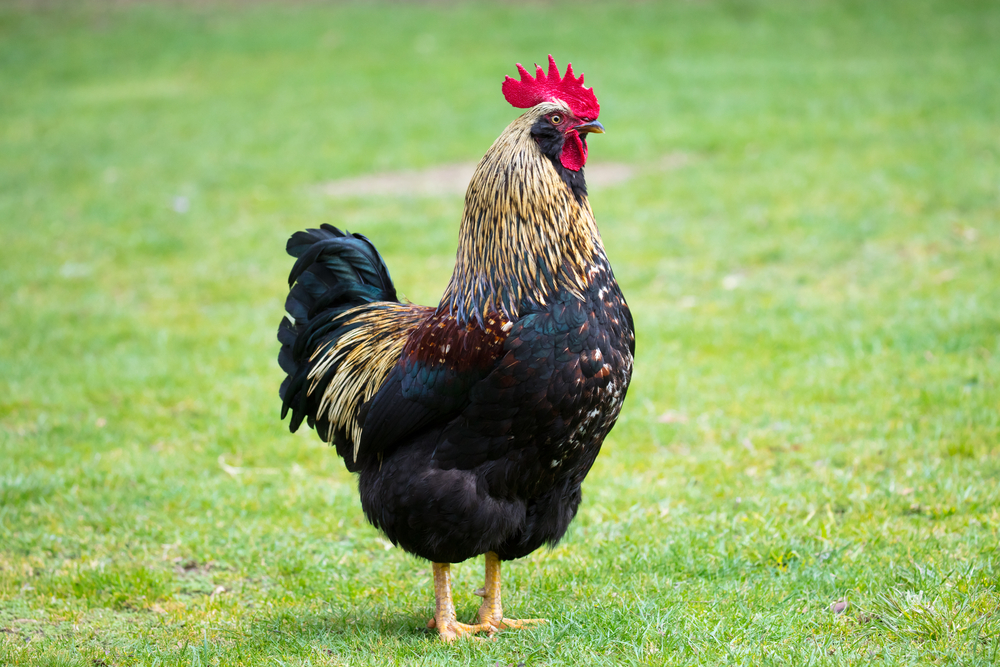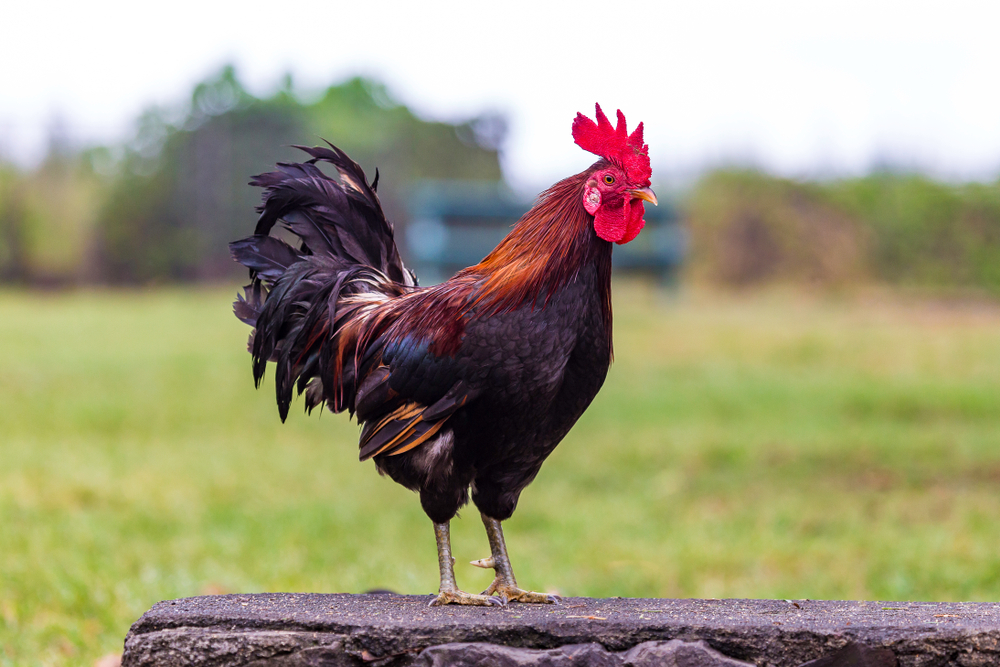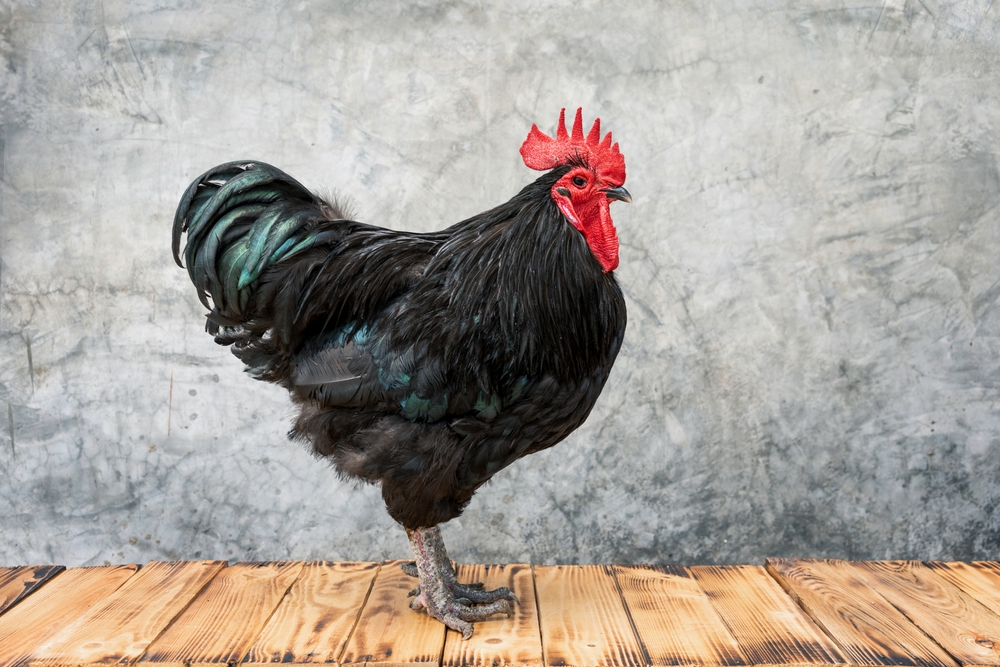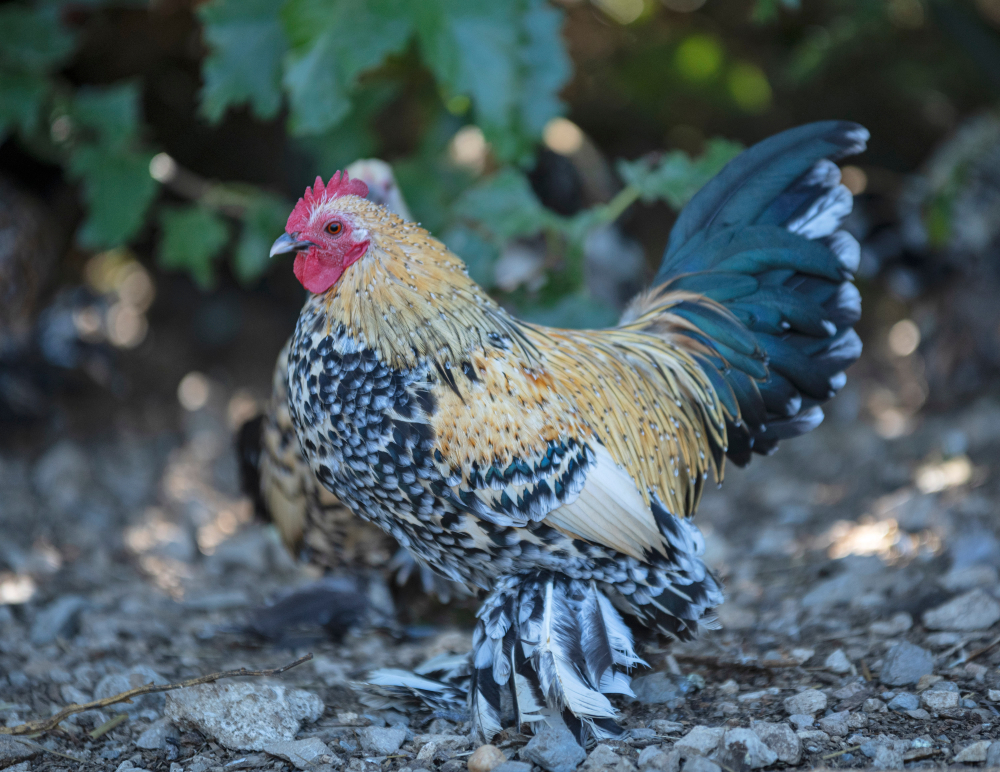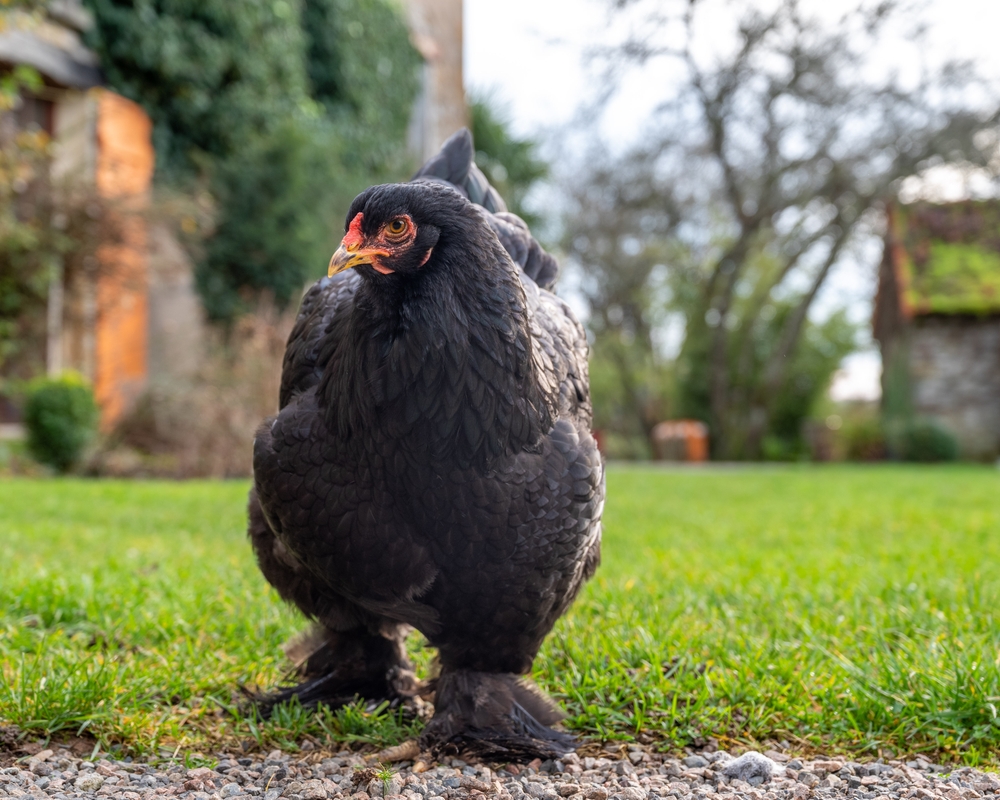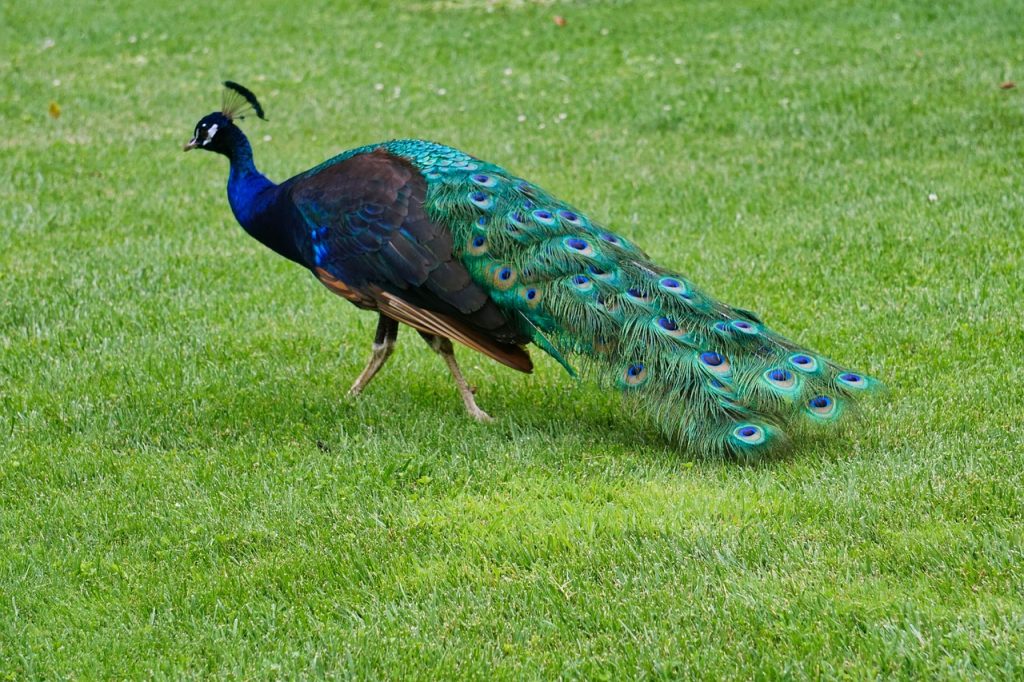The closest relative to the Hamburg is the Campine, another active, light-bodied European breed that shares similar ancestry and characteristics, such as patterned plumage, strong foraging instincts, and prolific white egg production. Both breeds are known for their alertness and suitability for free-range systems.
About
The Hamburg is an elegant, active chicken breed with origins tracing back to Germany and the Netherlands, where it was developed centuries ago. Prized historically for its beauty, hardiness, and excellent egg production, the Hamburg has long been a favorite among poultry keepers and show enthusiasts.
Hamburgs are small to medium-sized birds, with roosters weighing about 2–2.5 kg (4.5–5.5 lbs) and hens around 1.6–1.8 kg (3.5–4 lbs). They are best known for their striking plumage patterns, which include Silver Spangled, Golden Spangled, and various penciled varieties. These patterns feature crisp contrasts and precise markings, making them stand out in the show ring.
One of the breed’s notable features is its rose comb, which helps protect against frostbite in cold climates. They also have white earlobes, slender bodies, and long, well-carried tails that contribute to their refined appearance.
Hamburgs are exceptional layers for a heritage breed, producing 200–250 small to medium white eggs annually. They are not inclined to broodiness, which allows for consistent egg production throughout the season.
Highly energetic and excellent foragers, Hamburgs thrive in free-range settings where they can roam and hunt for insects. They are more flighty and independent than many breeds, preferring open spaces to confinement. Their alertness and quick reflexes make them less vulnerable to predators, but they may be harder to handle for those seeking a cuddly bird.
The Hamburg’s scientific classification is Gallus gallus domesticus, and it belongs to the family Phasianidae.
Physical Characteristics
Plumage:
Hamburgs are admired for their striking, patterned plumage, with varieties including Silver Spangled, Golden Spangled, Silver Penciled, Golden Penciled, Black, and White. In spangled types, each feather ends in a distinct white or gold tip surrounded by a black spangle; penciled varieties display fine, even barring across the feathers. The plumage lies tight to the body, giving a sleek and refined appearance.
Head and Comb:
The head is small and refined, with a rose comb that ends in a short, sharp spike at the back. Comb, wattles, and earlobes are bright red, while the earlobes themselves are smooth and white. The beak is short and slightly curved, ranging from horn to dark horn in color. Eyes are reddish bay.
Body:
Hamburgs have a slim, upright, and well-proportioned body, built for activity. The breast is moderately full, and the back is long and slopes gently toward the tail. They have a graceful, athletic build, reflecting their reputation as strong fliers and active foragers.
Legs and Feet:
The legs are clean (free of feathers), slender, and medium in length, with slate or lead-blue coloring in dark-feathered varieties and lighter tones in white varieties. Feet have four toes with hard nails for scratching and gripping.
Tail:
The tail is long, full, and carried at a high angle. Roosters have well-arched sickle feathers, while hens have a neatly fanned tail.
Size:
-
Male Weight: 5 lbs (2.3 kg)
-
Female Weight: 4 lbs (1.8 kg)
-
Bantam Variety: Males around 26 oz (740 g), females around 22 oz (625 g)
Sexual Dimorphism:
Males are slightly larger, with longer tail sickles, more iridescence in plumage, and more pronounced comb spikes. Females have a rounder body and more subdued coloration in patterned varieties.
Hamburgs’ sleek body, distinctive rose comb, white earlobes, and beautifully patterned plumage make them one of the most elegant and easily recognized light chicken breeds.
Reproduction
Mating Behavior:
Hamburgs are active, alert, and energetic, which can make them more spirited during mating than calmer breeds. Roosters are attentive and persistent, often courting hens with quick tidbitting calls and short chases. Because of their agility and smaller size, mating is generally quick and efficient.
Breeding Season:
While Hamburgs can breed year-round in mild climates, their natural breeding peak is in spring and early summer, when conditions favor chick survival. In colder climates, breeding activity follows the return of warmer weather and longer daylight hours.
Egg Laying:
Hamburg hens are prolific layers, known for their consistent production of smaller white eggs.
-
Annual Output: Around 200 to 250 eggs per year.
-
Egg Color: Pure white.
-
Egg Size: Small to medium.
They often continue laying well into winter compared to many other light breeds.
Broodiness and Incubation:
-
Hamburgs are rarely broody, making them less suited for natural chick rearing.
-
Eggs are typically hatched using an incubator or a more broody breed as a foster mother.
-
Incubation Period: About 21 days, with chicks developing quickly due to the breed’s smaller egg size.
Chicks:
-
Appearance at Hatch: Small, active, and alert; down coloration varies with variety but often includes dark and light striping or speckling for camouflage.
-
Self-Sufficiency: Highly energetic from the start, beginning to peck and forage within hours.
-
Growth Rate: Fast and lean, with early feather development.
Maturity:
Hamburg pullets often start laying earlier than many breeds, reaching point-of-lay at 4.5 to 5 months. Roosters are sexually mature around the same age.
Hamburgs’ high fertility, prolific egg-laying, and early maturity make them an efficient choice for egg production, though their lack of broodiness means artificial incubation is often necessary for breeding programs.
Lifespan
Lifespan in the Wild/Farm Setting:
Hamburgs are hardy and long-lived for a light chicken breed, typically living 5 to 8 years in well-managed backyard or farm environments. Their most productive laying years are usually the first 3 to 4 years, after which egg production declines but can continue at a reduced rate.
Lifespan in Optimal Conditions:
With excellent nutrition, predator protection, and prompt veterinary care, Hamburgs can live longer than average for an active layer breed.
-
Average Maximum Lifespan: 8 to 10 years
-
Exceptional cases: 10+ years, particularly in flocks kept for ornamental or exhibition purposes rather than high-volume production.
Threats to Longevity:
-
Predation: Their active and curious nature may lead them into open or unsafe areas, increasing exposure to hawks, foxes, raccoons, and other predators.
-
Stress and Injury: Because they are agile fliers and frequent roamers, injuries from collisions, entanglements, or fights with other animals can occur.
-
Disease and Parasites: Susceptible to lice, mites, and internal worms if not monitored, and prone to respiratory issues if housed in poorly ventilated coops.
-
Environmental Stress: While they are hardy in most conditions, extreme confinement can cause stress and reduce lifespan due to their high activity needs.
Hamburgs’ hardiness, early maturity, and natural vigor contribute to a longer-than-average lifespan for a light egg breed, provided they have space to roam and consistent care.
Eating Habits
Diet:
Hamburgs are omnivorous foragers that thrive on a combination of commercial poultry feed and naturally sourced foods.
-
Primary Feed: High-quality layer pellets or mash with 16–18% protein, plus added calcium for eggshell strength.
-
Foraged Foods: Insects, worms, seeds, grasses, weeds, and small invertebrates found while free-ranging.
-
Treats and Supplements: Whole grains (wheat, oats, corn), leafy greens, vegetable scraps, grit for digestion, and oyster shell for calcium.
Feeding Behavior:
-
Hamburgs are highly active and efficient foragers, often covering large areas in search of food.
-
They prefer free-range or spacious environments and are known to supplement much of their diet through natural foraging if given the opportunity.
-
They are less prone to overeating commercial feed compared to less active breeds.
Foraging Times:
-
Most active in early morning and late afternoon, avoiding intense midday heat.
-
In hot climates, they will seek shaded areas for foraging during warmer hours.
Adaptations for Feeding:
-
Strong, slender beaks well-suited for picking seeds and small insects.
-
Agile and fast-moving, able to chase flying insects and navigate dense vegetation.
-
High activity levels mean they require more calories than sedentary breeds to maintain weight and egg production.
Captive Diet Management:
-
Balanced feed should be available at all times to support their energetic lifestyle and high laying output.
-
Over-reliance on scratch grains can reduce nutritional balance and egg quality.
Hamburgs’ exceptional foraging ability, self-sufficiency, and preference for active feeding make them well-suited to free-range setups, where they can supplement their diet naturally while still maintaining strong egg production.
Uniqueness
Distinctive Plumage Patterns:
Hamburgs are famous for their striking feather patterns, especially the spangled and penciled varieties. Each feather is precisely marked, giving the bird an elegant, eye-catching appearance that stands out in poultry shows.
Rose Comb with Spike:
Their low, flat rose comb ending in a sharp spike at the rear is not only visually distinctive but also practical, offering improved frost resistance compared to single combs.
Prolific White Egg Layers:
Hamburgs are known for producing 200–250 small-to-medium pure white eggs annually, often laying consistently even during cooler months when other breeds slow down.
Endurance and Activity:
Highly active and athletic, Hamburgs are strong fliers and can cover large areas while foraging. Their high energy levels and alertness make them skilled at evading predators.
Long-Standing Heritage:
Originating in Europe several centuries ago—likely in the Netherlands or Germany—Hamburgs have been kept for both utility and beauty for generations. They were well-regarded in Victorian England for their elegance and productivity.
Free-Range Specialists:
They excel in free-range environments, sourcing a significant portion of their diet through natural foraging, which helps reduce feed costs for keepers.
Exhibition Appeal:
Their combination of unique patterns, graceful form, and active personality has made them a favorite in poultry exhibitions worldwide.
The Hamburg’s blend of ornamental beauty, consistent egg-laying, and athletic, hardy nature makes it one of the most versatile and admired light chicken breeds.
Be the First to Share Photos of This Species.
FAQ’s
1. What is the closest species to the Hamburg?
2. How does the Hamburg compare to other chickens?
Hamburgs stand out from many other chicken breeds because they:
-
Have distinctive spangled or penciled plumage that is rare and highly prized in exhibitions.
-
Are prolific layers of pure white eggs, often outproducing many heritage breeds of similar size.
-
Possess a rose comb with a spike, offering both ornamental appeal and frost resistance.
-
Are exceptionally active and flight-capable, unlike heavier or more docile breeds.
Compared to dual-purpose breeds like Rhode Island Reds or Plymouth Rocks, Hamburgs are lighter, more agile, and more ornamental, but produce smaller eggs.
3. What national parks provide the best chances to see a Hamburg?
As a domesticated poultry breed, Hamburgs are not found in the wild. However, they may be seen in heritage farms, agricultural museums, and poultry exhibitions located within or near parklands, such as:
-
Beamish Open Air Museum (United Kingdom)
-
Netherlands Open Air Museum – Arnhem (Netherlands)
-
Colonial Williamsburg Rare Breeds Program (Virginia, USA)
-
Sovereign Hill (Victoria, Australia)
-
Agricultural heritage displays at the Great Yorkshire Show (UK)
These settings maintain Hamburgs as part of livestock heritage programs and show displays rather than in feral populations.



































































